






8am

8pm

10pm
|


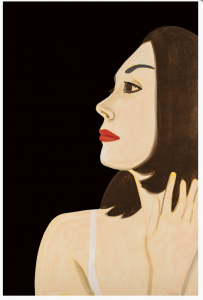
| Alex Katz Laura 1 2017 Archival pigment inks on Crane Museo Max 365 gsm fine art paper 46 x 30 1/2 in. Edition of 100 Pencil signed and numbered |
About the work:
Portraits are one of the great subjects of Alex Katz’s oeuvre. With his signature approach and style, he transforms his circle of family, friends and New York society figures into unforgettable icons. His works are defined by their flatness of color and form, their economy of line, and cool yet seductive emotional detachment.
Katz is the ultimate master of the flat style. His works may appear simple, but rather they are complex studies of color and shading. A student of color theory, he expertly captures depth and dimension with contrasting and complimentary hues like no other artist.
This week’s Work of the Week! WOW! is one of Katz’s most recent portraits, Laura 1. This work is the portrait of Laura Halzack, prima ballerina of the Paul Taylor Dance Company based in New York City. Alex Katz met Laura through Paul Taylor with whom he has collaborated with on over a dozen set and costume designs since 1960.
Laura, as many of Katz’s portrait subjects is presented without context. In the compressed visual plane, she is placed against a background of a single dark hue, which contrasts with the delicate peach tone of her skin. No additional narrative is provided other than her first name. This lack of narrative heightens the enigmatic qualities of the dancer, and allows Laura to exist in and of herself.
Influenced by film, television and billboard advertising, the composition of Laura 1 is like a cinematic close-up. The cropped view of the dancer’s profile is perfectly balanced with the black background. The work is cropped in a way that it seems Katz has captured a sincere, temporal moment, which he indeed has, given the ephemeral nature of dance.
Katz’s distinction as an artist lies in the fascinating reductive, flat style. His mastery of color and minimalism is timeless. His portraits, also have a distinctive quality in that he always represents the society of which he is a part of and, as a whole, can almost be experienced as a family photo album.
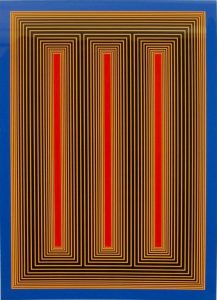
| Richard Anuszkiewicz Temple of the Golden Red 1985 Screenprint 32 x 24 in. Edition of 175 Pencil signed, dated and numbered |
About the work:
“I’m interested in making something romantic out of a very, very mechanistic geometry. Geometry and color represent to me an idealized, classical place that’s very clear and very pure.“ Richard Anuszkiewicz
Richard Anuszkiewicz was a central figure, along with Briget Riley and Victor Vasarely, in the Op Art movement. As a graduate student at Yale, he was mentored by the color theorist Josef Albers who would steer him on a course toward pure abstraction, grounded in the power of color. Most of his work trends away from personal emotion and drama, seeking rather visual investigations of formal structural and color effects. He made extensive use of ‘simultaneous contrast’ – where two colors, side by side, interact with one another to change our perception of them accordingly.
Among his most famed suites is the Temple Series; mesmerizing works, saturated with vibrant color arranged in geometric abstract compositions. The Temple Series originated after a 1981 trip to Egypt. He was inspired by the geometries of sacred temples,specifically those located in the Valley of the Kings. As is characteristic of most of his works, there are no specific references to individual structures, instead he uses the geometric framework as a space of color experimentation. The works in the series have been interpreted as illustrating visionary architect Buckminster Fuller’s notion of ‘Tensegrity’ – the balance between the forces of tension and integrity inherent in a physical structure.
This week’s Work of the Week! WOW! from the Temple Series is Temple of the Golden Red.
Temple of the Golden Red is a quintessential example of Anuszkiewicz’s mature style. Incorporating a repeating pattern of vertically oriented rectangles surrounded by concentric lines of startlingly different color. It contains three central rectangles of saturated crimson surrounded by lines of alternating but as equally saturated yellow and black. Symmetry is essential in Anuszkiewicz’s work, and by juxtaposing opposite colors of equal saturation, he accomplishes a visual fluctuation between figure and ground, creating a vibrating or pulsating sensation in the eye. The result is a release of energy, a transformation of color into motion. Like all great work that depends in large measure on color for its impact, the intensity lays in the way the eye and brain interpret visual information.
As with most artworks, Anuszkiewicz’s work is much more powerful in person. From Temple of the Golden Red emanates a profound luminosity, appearing as if lit from an inner source. New York Times art critic Holland Cotter described Anuszkiewicz’s works by stating, “The drama – and that feels like the right word – is in the subtle chemistry of complementary colors, which makes the geometry glow as if light were leaking out from behind it.” The artwork also packs a powerful monumentality, a result of its architectonic framing that gives the illusion of standing in front of a physical temple. Despite that the work is inspired from a trip to Egypt, the ‘fluting’ can seem to have more in common with classical ancient Greek columns.
Within the boundaries Anuszkiewicz set for himself—vertical bars of color surrounded by the pinstriped framework, the range of effects achieved is remarkable. The colors appear to blaze forth or recede into the distance and the choice of colors projects a mood, in this case, a jazzy up-tempo. Despite the restless optical power of the piece, it is thoroughly classical.
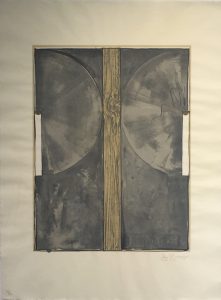
| Jasper Johns Device 1971-72 Lithograph 33 1/2 x 29 in. Edition of 62 Pencil signed, dated and numbered |
About the work:
“I tend to like things that already exist.” Jasper Johns
Jasper Johns is the world’s most critically acclaimed living artist. His work bridges the immediate post-World War II modernist trends of Surrealism and Abstract Expressionism with subsequent movements of Pop art, Minimalism, and Conceptual art.
Johns was ushered into the New York art scene in 1953, when he met Robert Rauschenberg. The two artists shared an intense relationship, both romantic and artistic, from 1954 to 1961. They had neighboring studio spaces and deeply influenced each other’s artwork, exchanging ideas and techniques that would allow them to break from Abstract Expressionism. Their relationship would lead to Johns’ discovery by famed art dealer Leo Castelli, who, while visiting Rauschenberg’s studio met Johns and saw his work. Castelli offered the young Jasper Johns his first solo show on the spot. It was during his first exhibition that Alfred Barr, the founding director of the MoMA, purchased a number pieces that were on display, instantly making Jasper Johns a force in the art world.
Johns’ breakthrough style was to appropriate popular iconography in his works with a rich treatment of the surface as lush and painterly. By representing common objects and images in the realm of fine art, Johns broke down the boundaries traditionally separating fine art and everyday life. However, rather than direct representation or abstraction, Johns made signs, like flags and targets, iconic images in his works. The “things the mind already knows” were his ideal subject because of the varied meanings each carried with it. This would lay the foundation for the Pop art movement’s aesthetic embrace of commodity culture, paving the path for Andy Warhol, James Rosenquist among many, many other post-war artists.
While Johns continued to produce paintings that incorporated Abstract Expressionism’s gestures and color blocking, he shifted his focus from the finished image to the concept behind it. His process, which he believed to be the actual art, took on greater importance. The artist made a seamless transition into print making. For Johns, printmaking was a medium that encouraged experimentation through the ease with which it allowed for repeat endeavors. His innovations in screen printing, lithography, and etching revolutionized the field.
As the Pop art movement grew around him, Johns left behind the colorful works filled with familiar gestures and images and turned to a darker palette. Some critics attribute the shift away from color and toward the grays, blacks, and whites that dominate many of his canvases from the early 1960s to the rocky end of his relationship with Rauschenberg.
This week’s Work of the Week! WOW! is Jasper Johns’ Device.
Created in 1971-72, Device masterfully plays with different tones of grey, white and beige. The works that use what Johns called “the device,” were made from two stretcher bars attached to a canvas frame with butterfly screws, creating a mechanical arm, that would be used to scrape the paint on the surface in a circular shape. All of these elements from the “real” world undercut the traditional idea of a painting as an illusion. The development of the device theme in Johns’ work progressed to incorporate other themes, such as the abundant use of text. His techniques stress conscious control rather than spontaneity.
Over the past fifty years Johns has created a body of rich and complex work. His rigorous attention to the themes of popular imagery and abstraction has set the standards for American art. Constantly challenging the technical possibilities of printmaking, Johns laid the groundwork for a wide range of experimental artists that came after him.

| Andy Warhol The Shadow, from Myths (FS II.267) 1981 Screenprint on Lenox Museum Board 38 x 38 in. Edition of 200 Pencil signed and numbered |
About the work:
As a keen observer of the emergence of America as the global superpower it is today, Andy Warhol captured deep American truths and fantasies. “Everybody has their own America, and then they have pieces of a fantasy America that they think is out there but they can’t see,” he once observed. Nowhere is this national fantasy clearer than in Warhol’s Myths Series of 1981.
The suite, composed of 10 iconic representations of recognizable figures of American film, history and culture encompass Warhol’s own life and the magic of 20th century American Pop Culture, or American Mythology. The term ‘Mythology’ (or ‘Myth’) often-times evokes the collected stories of the Ancient Greeks and Romans, however, Mythology is a feature of every culture. The collection of myths of any society defines its spirit and soul.
In the Myths Series, Warhol selected a range of 10 uniquely American personas, from Santa Claus to Uncle Sam, each artwork revealing facets of Warhol’s personality and desires. As a sick child, he was inspired by the duality of Clark Kent/Superman and famously wanted to be regarded as strong an american symbol as Mickey Mouse. Warhol so ardently wanted to be a part of American Mythology that he used his own self-portrait to take on the role of one of the characters in the Myths suite. Overtly self-referential, the artist placed himself among his idols.
This week’s Work of the Week! WOW! is The Shadow, from Myths, in which Andy Warhol used his own face to personify a fictional American icon.
While many of the referenced characters of the suite require no introduction, today ‘The Shadow’ is a more niche symbol of American Pop Culture. ‘The Shadow’ was a fictional pulp-novel character of the 1930’s, a crime-fighting hero of Warhol’s childhood. He wore a wide-brimmed black hat and a black, crimson-lined cloak with an upturned collar over a standard black business suit.
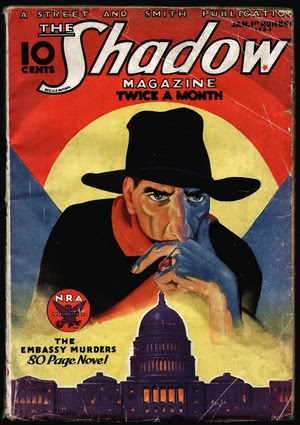 The popular series was also adapted into a Radio Show and a comic strip during Warhol’s lifetime.
The popular series was also adapted into a Radio Show and a comic strip during Warhol’s lifetime.
 |
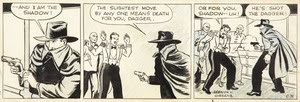 |
The portrait is based on a photograph of Warhol as the fictional character and although he doesn’t wear The Shadow’s black cloak or broad-rimmed hat, the crimson lighting illuminating Warhol’s face, which references the red lining of The Shadow’s cloak, causes a strong shadow to be cast of his profile in the background. While peering at the viewer, Andy Warhol crafts a personification of himself masquerading as a hero.
Andy Warhol exhibited an unerring sense for the powerful motifs of his time – contemporary images that capture the modern imagination as completely as the gods and goddesses of ancient mythology once did. The images presented in Myths are nostalgic representations of America, each theatrically reflecting American fantasies, hopes, fears and dreams. Warhol gives these already established icons his signature pop-style treatment, inserting his own image into the narrative of pop culture.
The Shadow from Myths is a screenprint on Lenox Museum board with Diamond Dust covering the full sheet. The Diamond Dust, heavily applied, adds a luster to the work, but also lends to its mysteriousness, thus accentuating The Shadow. It its a very impressive work.


|
About the work:
Frank Stella is one of the most highly regarded post-war American artists still working today. He is a rule-breaker, interested in furthering the History of Art by constantly and deliberately taking us down new paths.
Upon moving to New York after his studies at Princeton, Stella was first inspired by the Abstract Expressionists, but also by the ‘flat’ works of Barnett Newman. It was however, the paintings of Jasper Johns, exhibited at Leo Castelli’s famed gallery in 1958, that lead Stella to start using his now-trademark stripes as a compositional tool. The controlled minimalist works are among his most recognizable. Stella didn’t change the course of Art History simply through his study and use of a radically different style, he also approached diverse materials in a revolutionary way.
Frank Stella’s first experience in painting was re-coating houses and boats, and he would continue to paint houses after his move to NY to make ends meet. Over the course of his 60-plus-year career, Stella would regularly revisit unmixed house and car paint in addition to using house-painter brushes. Stella’s process was documented in Hollis Frampton’s photo essay “The Secret World of Frank Stella” which showed the artist’s approach to canvas as being the same as he would a house – filling a space with increasingly proximate concentric lines. In his striped works, Frank Stella never used masking tape. He would never even measure out the lines, rather the works are free-hand.
This week’s Work of the Week! WOW! is the Benjamin Moore Series. This series is one of Stella’s most iconic. Andy Warhol recognized the genius of Stella and purchased the complete set of originals himself.
All the titles of Stella’s works are significant. The Benjamin Moore Series makes reference to the type and brand of paint that was used in the creation of the works. The use of store-bought house paints is significant in that it roots his art in the post-war commodity culture. In naming the series after a company, he also explored the rise of advertising and branding. The titles of each individual piece are also important to note – they are all named after historical battles fought during the Civil War.
The two works featured at Gregg Shienbaum Fine Art are Palmito Ranch and Hampton Roads. Both battles were of great significance. The Battle of Hampton Roads, often called either the Battle of the Monitor and Merrimack or the Battle of Ironclads, fought on March 9, 1862, was the most important naval battle of the Civil War from the perspective of naval development. It was History’s first duel between ironclad warships. The Battle of Palmito Ranch is regarded as the final battle of the war, fought May 12 and 13, 1865, on the banks of the Rio Grande in Texas. Despite that Robert Lee had surrendered a month prior to Ulysses Grant, the attack was ordered on the Confederate Army for unknown reasons. Anecdotes suggest that Union Colonel Theodore Barrett wanted to see combat before the end of the war. The names of Stella’s works are significant, loading abstract images with meaning. The complete series is a historical narrative composed of abstract works.
The works in the series are among Stella’s most reductive compositions. It is the formal rather than the thematic matter that Stella engages in. The set plays with maze-like patterns, simple diagonals, and understated and stacked compositions, where the painted line creates an even, horizontal rhythm. Stella shows us the environment of the battles of the Civil War with paint straight from a can – intense and flat. The saturated palette, measured proportions, and glowing presence are at once immediately vibrant and classically timeless.
As Adam D. Weinberg, director of the Whitney has said “Frank is a radical innovator who has, from the beginning, absorbed the lessons of art history and then remade the world on his own artistic terms. He is a singular American master.”